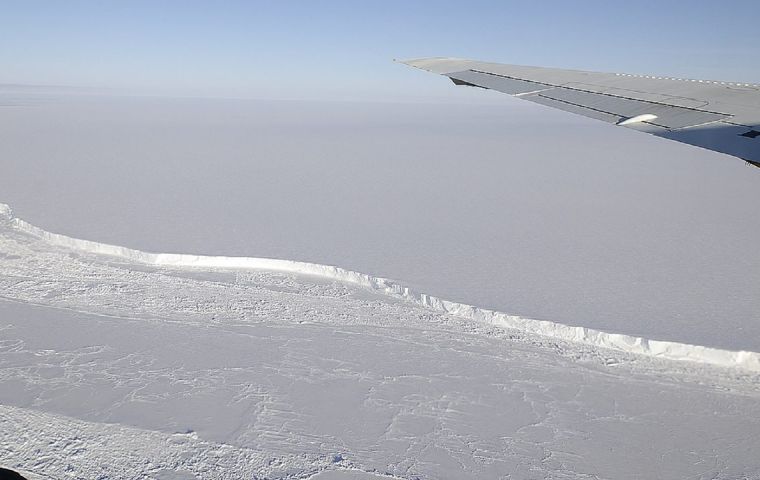MercoPress. South Atlantic News Agency
Crack in Antarctica's Brunt Ice Shelf: further evidence of climate change?
 Its size is not what makes it noteworthy, but rather the way climate change might be destabilizing other ice shelves like Brunt
Its size is not what makes it noteworthy, but rather the way climate change might be destabilizing other ice shelves like Brunt A chasm and a crack on the Brunt Ice Shelf in Antarctica are creeping closer and closer to one another, and when the two finally meet, a slab of ice twice the size of New York City will break away and float out to sea. The two glacial flaws are about 4km apart, and it could take days or months for them to finally rendezvous. But when they do, the iceberg that forms in the Weddell Sea will not be the largest to orbit Antarctica. In fact, it might not even make the historical top 20.
Its size is not what makes it noteworthy - it is what the break itself says about the natural process of iceberg calving, the way climate change might be destabilizing other ice shelves like Brunt, and how the movement could jeopardize the critical scientific research human residents have conducted there for more than 60 years.
Since 1956, British scientists have been studying geology, glaciology and the atmosphere at the Halley research station located on the Brunt Ice Shelf. The lab has been torn down and rebuilt many times over the decades, and took its most recent form in 2012 when the Halley VI Research Station - a mobile, modular structure - delivered its first scientific data.
That same year, satellite monitoring showed that a large chasm in the ice shelf - officially named Chasm 1 - was growing for the first time in more than three decades. By a glaciologist's definition, a chasm is described as a very large crack that visibly extends through the ice shelf to the sea.
If it kept growing, Chasm 1 would have eventually marooned the Halley VI station, so the British Antarctic Survey decided to move its researchers further inland and a safe distance from the chasm during several months in 2016 and 2017.
But in October 2016, another crack - called the Halloween crack - quickly formed 17km north of the research station and continues to extend east.
In the two years since, Chasm 1 has crept closer to the Halloween crack, preparing scientists for the inevitability of a iceberg breakaway that could have greater consequences for the stability of the entire Brunt Ice Shelf.
Nasa predicts the mass could span 1,700 sq km, which would make it the largest iceberg to break from the Brunt Ice Shelf in more than 100 years.
“It's a large berg, but it's not a massive berg - not by Antarctic standards,” said Dr Christopher Shuman, a research scientist at the University of Maryland Baltimore County's Joint Centre for Earth Systems Technology at Nasa.
”The impact on the area is that these rifts have reactivated, and we're not sure why. A new rift (Halloween crack) formed it what was thought to be a pretty stable ice shelf.“
Scientists have only been studying glacier shelves for a little over 100 years, so it is difficult to say whether icebergs are calving at a higher rate at this location on the Brunt Ice Shelf, said Prof Helen Fricker, a glaciologist at the Scripps Institution of Oceanography.
”I don't think you can link one calving event to climate change,“ Prof Fricker said. ”That isn't to say Antarctica isn't undergoing rapid changes that are linked to climate change. But it's in another region of Antarctica.”
Iceberg calving is a normal, natural process that helps maintain Antarctica's net land mass. Floating ice shelves fringe the coasts of the continent, growing upwards and outwards as heavy snows fall.




Top Comments
Disclaimer & comment rulesCommenting for this story is now closed.
If you have a Facebook account, become a fan and comment on our Facebook Page!